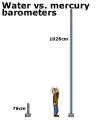|
Mercury and heavy metal pollution
Also known as Quicksilver, mercury is a silvery white liquid that slowly
tarnishes in moist air. Mercury was used by the ancient Chinese and
Hindus and has been found in an Egyptian tomb dating back to around
1500 BC. During the European Middle Ages and in China, mercury was used
to make potions for eternal life or to try and turn base metals into
gold! Neither venture was successful. Mercury is a poison so it tended
to shorten life, not extend it and turning base metals into gold requires
the use of advanced nuclear physics, not available in the Middle Ages.
Occurrence
 Mercury is rare in the Earth's crust. Its principal
ore is
Mercury is rare in the Earth's crust. Its principal
ore is  the
red mineral cinnabar called mercury sulfide. Native mercury occurs in
droplets, usually in conjunction with cinnabar, near volcanoes or hot
springs. Mercury is not a very reactive metal and hence it is reasonably
easy to release from its ore. Mercury can be obtained by heating cinnabar
and collecting the mercury vapours in a still. the
red mineral cinnabar called mercury sulfide. Native mercury occurs in
droplets, usually in conjunction with cinnabar, near volcanoes or hot
springs. Mercury is not a very reactive metal and hence it is reasonably
easy to release from its ore. Mercury can be obtained by heating cinnabar
and collecting the mercury vapours in a still.
Properties and uses
Mercury still holds great interest for the modern student of chemistry,
being the only liquid metal. Its low melting point of -38.9°C and
relatively high boiling point for a liquid of 356.9°C, gives mercury
a large range of temperature as a liquid.
 Mercury
makes an excellent liquid to use in thermometers. This is because mercury
expands uniformly as it is heated and has a high surface tension. Thus,
when a thermometer is warmed, the mercury rises at a constant rate within
the thermometer and does not wet or cling to glass. Mercury
makes an excellent liquid to use in thermometers. This is because mercury
expands uniformly as it is heated and has a high surface tension. Thus,
when a thermometer is warmed, the mercury rises at a constant rate within
the thermometer and does not wet or cling to glass.
Mercury's high density of 13.5 grams per cubic centimetre, means that
most material will float on its surface. A person with density around
1 g/cm3 easily floats on mercury, not getting wet because
of mercury's high surface tension.
 The high density of mercury and a high surface tension makes mercury
the perfect liquid for measuring gas pressures in barometers and manometers.
For example, a column of mercury 76cm high exerts the same pressure
as the atmosphere on the surface of the Earth at sea level. If water
were used instead of mercury, a column 1026cm or 10.26 metres, high
would be needed.
The high density of mercury and a high surface tension makes mercury
the perfect liquid for measuring gas pressures in barometers and manometers.
For example, a column of mercury 76cm high exerts the same pressure
as the atmosphere on the surface of the Earth at sea level. If water
were used instead of mercury, a column 1026cm or 10.26 metres, high
would be needed.
When the high electrical conductivity of mercury is added to its already
unusual features, a whole new range of uses become possibilities. Mercury
is used in electric switches, fluorescent and mercury-vapour lamps,
mercury cell batteries, and as electrodes in the industrial production
of chlorine and caustic soda.
Toxicity
 Mercury
is highly toxic. Care must be exercised in its handling and transport.
Poisoning may result from inhalation of mercury vapour, ingestion of
mercury compounds, or absorption through the skin. Mercury
is highly toxic. Care must be exercised in its handling and transport.
Poisoning may result from inhalation of mercury vapour, ingestion of
mercury compounds, or absorption through the skin.
The Mad Hatter in Alice and Wonderland had jitters, convulsions and
stuttering all symptomatic of mercury poisoning. Hats at that time were
made of felt, and mercury compounds were used in the felt making process.
Mercury poisoning
Mercury was involved in a mass poisoning during
the 1950s in Minamata, Japan, where a whole community was poisoned by
eating fish caught in the mercury polluted waters in Minamata Bay. Babies
were born deformed, children and adults lost the use of their limbs
and many died.
As a result of the Minamata poisonings and other cases, mercury has
been withdrawn from many uses and industrial processes and is now used
only sparingly in laboratories and specialised industrial processes.
Mercury pollution
The high density of liquid mercury means that if it escapes into the
environment it will flow to, and accumulate in, low-lying places. In
Minamata, the mercury escaped from an industrial plant and flowed through
drainage outlets to accumulate in the mud in the bottom of the local
bay.
In the mud, bacteria converted the metallic mercury into simple mercury
organic compounds, which then accumulated in the crabs and shellfish
living on the bottom of the bay. The shellfish were eaten by other fish
and by the local community. The mercury then accumulated in the people
attaching itself to the protein in the fastest growing parts of the
victims' bodies, usually in the central nervous system. The unborn babies
of pregnant women and children were the most at risk because their bodies
were growing the fastest. Babies and children were often affected when
adults in the same house showed no sign of mercury poisoning.
Mercury's ability to accumulate in one place and combine with protein
in living things is typical of many other "heavy metals" like
cadmium, lead and zinc. The only way to effectively stop poisoning from
mercury and the other heavy metals is to stop them getting into the
environment and cleaning up already polluted areas.
|